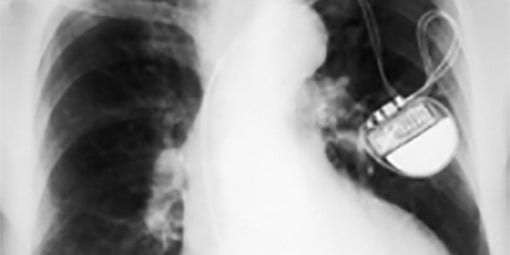Pacemaker Implantation
The heart has a natural pacemaker and an electrical system that directs the heart muscle to beat. Sometimes problems can arise either in the pacemaker or with this electrical system that can cause the heart to beat too slowly or stop. So a mechanical permanent pacemaker needs to be inserted to take over the deficient natural electrical source.
A pacemaker that is implanted to replace your natural system is made up of a pulse generator that lies under the skin just below the collarbone (usually) and 1 to 3 leads that arise from the pulse generator and go into the heart. The leads transmit the electrical impulses from the pulse generator to the heart muscle causing it to beat.

Procedure: WHAT IS INVOLVED IN PACEMAKER IMPLANTATION?
Insertion of a pacemaker is a very common procedure. This is performed under local anaesthetic with sedative medication to make you feel comfortable. The procedure takes approximately 1 hour and is performed in the cardiac catheter laboratory. This is a special room that has a patient table, X-Ray tube, ECG monitors and other equipment. The staff in the lab will all be dressed in hospital theatre clothes and during the procedure will be wearing hats and masks. Many ECG monitoring electrodes will be attached to your chest area. A nurse or doctor will insert an intravenous line usually into the back of your hand. This is needed as a reliable way to give you medications during the study without further injections.
You will also have a blood-pressure cuff attached to your arm that will automatically inflate at various times throughout the procedure. There will also be considerable attention at cleaning the skin under the collarbone where the pacemaker will be inserted. You will also receive antibiotics prior to the procedure. You should ensure that you inform the Doctor if you have any allergies.
The pacemaker is inserted just under the collarbone. The area is prepared with a special sterile solution that may feel cold. A large sterile sheet that will partly cover your face will cover you. You will be able to look out from under the sheet to the side and a nurse will be present at all times. You will be given oxygen to breathe by a small tube that is positioned under your nostrils.
At the start of the procedure, the doctor will inject local anaesthetic into the area under the collarbone where the pacemaker is to be inserted. This will sting momentarily but the area will then be numb. During the procedure you may feel some firm pushing in the shoulder area but this should not be painful. If you experience pain or discomfort you should tell the nurse or doctor. After the procedure you will have some bruising and discomfort in the area of the pacemaker that may persist for several weeks. You should avoid strenuous activities with your arm for a period of 4 weeks. You should refrain from driving for 2 weeks.
You will be allowed to go home 1 or 2 days after the procedure.
PACEMAKER INSERTION RISKS
Pacemaker implantation is a very common and low risk procedure and should a complication arise, it will be dealt with immediately. Although most people undergoing pacemaker implantation do not experience any complications, you should be aware of the following risks:
- All patients will be left with a scar and a pacemaker (which can often be felt) under the skin.
- Most patients will have some initial bruising. If you are taking aspirin, clopidogrel, warfarin or other “blood thinners” the bruising may be significant.
- 1 in 40 – The pacemaker leads can move after the procedure – this may require a repeat procedure to fix the problem.
- 1 in 100 – An infection may arise at the pacemaker site. This is a difficult problem to treat and may require the pacemaker to be removed.
- 1 in 100 – A lung may collapse. This may require the insertion of a tube to reinflate the lung.
- 1 in 200 – A blood clot may form in the subclavian vein. This is the vein that the leads go through to get to the heart.
- 1 in 1000 – The leads can puncture the heart muscle, giving rise to cardiac tamponade that may be fatal.
- 1 in 1000 – A blood clot can form in the legs and go to the lungs. This may be fatal.
- Rare – It is possible although rare to have a life threatening allergic reaction to a medication, a stroke, heart attack or die as a result of a pacemaker insertion.
Obviously every effort is made to minimise the risks of the procedure and you should be aware that emergency equipment is available to deal with any complications that occur.
It is important to understand that these are average risks. Your individual risk may be higher or lower depending on a number of factors such as your age and general health. Your cardiologist knows these risks and has considered them before recommending that you undergo a pacemaker implantation.
